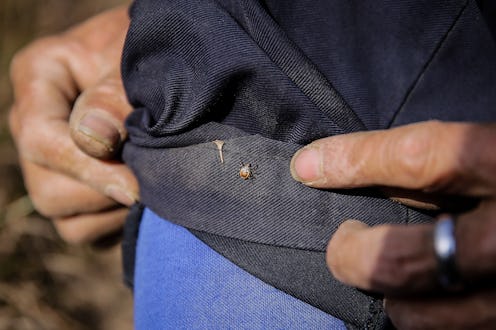
The weather is nice and the opportunities for outdoor recreation are endless — what could go wrong? Of course, the trade-off for spending time outside is dealing with nature, which can be a terrifying prospect. Mosquitoes and ants are annoying, but other insects can actually be dangerous — like ticks. The U.S. National Library of Medicine describes ticks as "small, bloodsucking parasites," which is a casual way to describe a mini-vampire. They can also carry several diseases, such as Lyme disease, tick-borne relapsing fever, or Rocky Mountain spotted fever. A bite from a Lone Star tick can even cause an allergy to red meat, which is a truly scary prospect. If you suspect you've been bitten by a tick, it can be hard to know what to do next, but it's important to recognize the potential signs.
The first thing to do is determine whether you've actually been bitten by a tick, especially because tick, mosquitoes and spider bites are easily confused. If you've been bitten by a tick, according to Everyday Health, the bite may cause a rash, and if that rash looks like a bullseye, it can be a sign of Lyme disease.
There's another ghastly sign that you've been affected by a tick: It may still be embedded in your skin. The Johns Hopkins Medicine Lyme Disease Research Center says you'll need a tweezer and a generous friend to remove the unwelcome intruder. You grab the tick with tweezers and pull it out of the skin, but it can take a while to actually remove it. The Centers for Disease Control & Prevention warns that twisting the tick can cause some of it to remain in your skin, so you want someone with steady hands.
Mayo Clinic recommends contacting your doctor if you're having trouble removing a tick. Once you're confident you've fully removed the tick, you should wash your hands and the area around the bite. Mayo Clinic also says to freeze the tick instead of throwing it away — if you have complications due to a tick bite, having the tick on-hand could help with a diagnosis.
Once a tick is gone, you need to keep an eye on your skin, which will almost certainly be irritated from the encounter. If the rash gets bigger, you should see a doctor, according to Mayo Clinic. Medical care is also a necessity if you're having flu-like symptoms or the bite is showing signs of infection. If you feel bad immediately after a tick bite, Mayo Clinic says to seek immediate medical attention.
If you catch a tick right after it bites you, you're at a lower risk of experiencing any long-term side effects. Most ticks need to be attached for at least 36 hours to cause Lyme disease, according to the CDC, so if you practice tick checks after being outside, you have a strong possibility of avoiding it. Unfortunately, the ticks that cause Lyme disease can be frighteningly small — about the size of a seed on a bagel — and can attach in areas that you wouldn't usually check. According to NPR, this includes your scalp, armpits and even your groin. Lyme disease can lead to complications throughout your nervous system, and it's important to seek treatment if you think you've been affected.
Instead of locking yourself inside for the rest of the year, it's best to learn more about ticks and how to avoid them. Ticks are found pretty much everywhere in the U.S. with the exception of Alaska, although certain states have more tick populations than others. You can use the CDC's mapping tool to figure out just which insects you should be concerned about. You should also be careful in wooded areas and places with tall grass — you're more likely to get bitten there. Try tucking your pants into your socks and using a chemical repellent when you're out hiking — MedlinePlus says this reduces the risk of you getting bitten. If you check thoroughly for ticks after spending time outside along with these precautions, you should be able to enjoy summer without any surprise visitors.